-
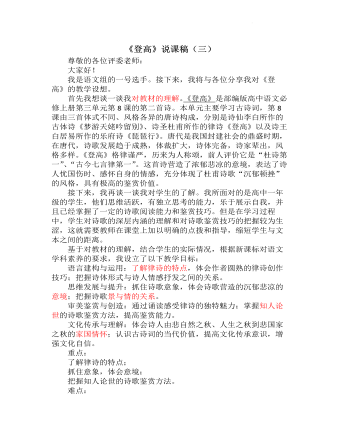
《登高》说课稿(三)2022-2023学年统编版高中语文必修上册
④结合杜甫的身世遭遇,你认为这里的“艰难苦恨”包含着哪些情感?第五步是拓展延伸对比阅读李白的《梦游天姥吟留别》,讨论诗体形式与诗人情感抒发之间的关系。第六步是达标检测我将紧扣考试题型,以理解性默写的形式,当堂检验学生对诗歌的掌握情况第三环:课后跟踪课后作业:①背诵并默写诗歌②鉴赏诗歌《秋兴八首》 (其一) ,找出诗歌所用意象,体会意境,表达情感。玉露凋伤枫树林,巫山巫峡气萧森。江间波浪兼天涌,塞上风云接地阴。丛菊两开他日泪,孤舟一系故园心。寒衣处处催刀尺,捣衣砧上拂还来。最后,我来说一说我的板书设计,我的板书设计简洁明了,清晰直观,能够突出本课的重点和难点。以上就是我本说课的全部内容,再次感谢各位考官的聆听!
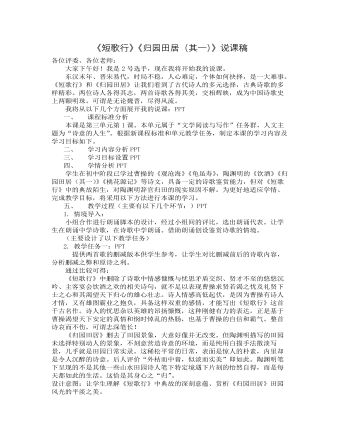
《短歌行》《归园田居》说课稿 2021-2022学年统编版高中语文必修上册
3. 教学任务二:PPT子任务一、二、三感悟诗情:那么为什么不能轻易对诗人诗歌进行删减呢?除了诗歌语言及内容方面的影响外,还有重要的一点就是:感情。情感是诗歌的尺度,而非长短。下面将从知人论世的角度再读诗歌。重点赏析曹操的“忧”与“解”和陶渊明的“误”与“归”。通过编写诗人年谱的方式,呈现诗人的各个人生阶段的经历和当时的时代背景,让诗人回到历史现场,让自己代入诗人境遇,以意逆志。通过查阅资料和编写年谱,可以了解到:曹操既能横槊,又能赋诗,如曹丕在《典论·自叙》中所说:“上(曹操)雅好诗文书籍,虽在军旅,手不释卷。”《短歌行》中多用典故和善用比兴或许就源于此。其次,曹操虽出身仕宦,但门第不算高贵,这样的家庭地位让他有着出人头地、建功立业的迫切愿望,因此,“唯才是举”是曹操出于现实的理性选择。再次,曹操写《短歌行》的确切时间已难考证,如取赤壁大战前的说法,曹操已五十四岁,来日无多的紧迫感、贤才归附的愿望自然尤为强烈。
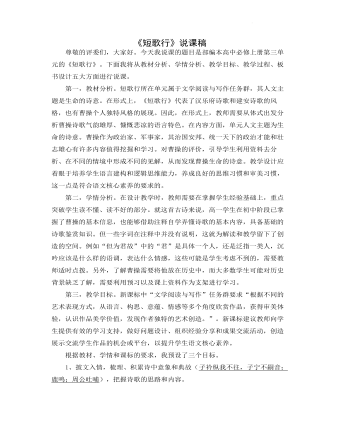
《短歌行》说课稿2022-2023学年统编版高中语文必修上册
第二课时为知人。即利用预习所查到的资料、学生之间的分享以及教师预备的材料,合作探究三个问题:曹操为何如此渴望贤才?天下归心的愿望是否实现?如何评价曹操?本课时采用创设情境的方式,从刘备、曹丕、晚年曹操等多重角度评价曹操,自领角色,利用资料有逻辑地证明自己的观点。教师出示不同学者评价,师生共同研讨评价的技巧和原则,尝试写作短小文学评论。这是解决忧的果。第三课时为回味。创设诵读比赛的情境,在比赛和评价中研讨标点符号的作用,如何读出曹操诗歌独特的特点,以及带着对曹操的认识读出自己的理解。(每组评出最佳朗读者和最佳评论员,上传优秀视频)。这是为了让学生最后读出忧。第五,板书设计。以上是我本节课教学设计的板书,体现了分析本首诗的基本思路和学习方法。
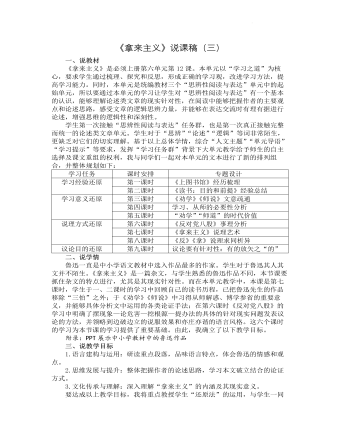
《拿来主义》说课稿(三) 2021-2022学年统编版高中语文必修上册
学生展示:鲁迅在《拿来主义》讨论“送去主义”时使用的不是徐、刘二人欧洲巡展的事实,而是《大晚报》评价二人欧洲巡展为“发扬国光”这一事实,故用了“叫作”,且是加引号的“发扬国光”;用“送”字表明自己针对的对象不是梅兰芳本人及其艺术,而是“送梅兰芳博士到苏联去”的人及其行为,即强行将中国戏剧与象征主义相联系的牵强附会的行径。可见,鲁迅针对的是当时国民政府一味送去的行径和主流媒体宣扬为“发扬国光”的舆论导向。设计意图:有的放矢,针砭时弊是杂文的突出特征。耙子指向哪儿、时弊是什么是必须思考的问题。有学生误以为鲁迅在批判徐悲鸿、刘海粟、梅兰芳等人,甚至调侃说鲁迅“怼人狂魔”“老阴阳师”。通过此活动,细读文本,还原历史,抓住“叫作”与“送”的主体,找准鲁迅批判的对象和针对的现象。同时,引导学生用不可随意使用所谓网络“梗文化”来消解名人、伟人等事迹的严肃性,不可以娱乐心态品读经典作品。
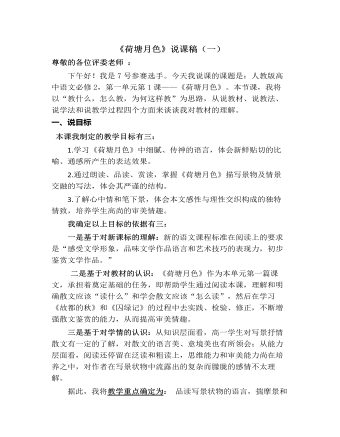
《荷塘月色 》说课稿(一) 2021-2022学年统编版高中语文必修上册
一、说目标本课我制定的教学目标有三:1.学习《荷塘月色》中细腻、传神的语言,体会新鲜贴切的比喻、通感所产生的表达效果。2.通过朗读、品读、赏读,掌握《荷塘月色》描写景物及情景交融的写法,体会其严谨的结构。3.了解心中情和笔下景,体会本文感性与理性交织构成的独特情致,培养学生高尚的审美情趣。我确定以上目标的依据有三:一是基于对新课标的理解:新的语文课程标准在阅读上的要求是“感受文学形象,品味文学作品语言和艺术技巧的表现力,初步鉴赏文学作品。”二是基于对教材的认识:《荷塘月色》作为本单元第一篇课文,承担着奠定基础的任务,即帮助学生通过阅读本课,理解和明确散文应该“读什么”和学会散文应该“怎么读”,然后在学习《故都的秋》和《囚绿记》的过程中去实践、检验、修正,不断增强散文鉴赏的能力,从而提高审美情趣。

《荷塘月色》说课稿 (二)2021-2022学年统编版高中语文必修上册
本环节利用多媒体展示的教学手段,通过创设优美的情景来渲染气氛,引导学生接受美的熏陶,增强学生学习兴趣。教师先播放莲花的图片,让学生们谈谈自己联想到的诗词曲赋或文章,来激发学生的学习热情,随后教师总结,引出现代写荷花的名篇《荷塘月色》,从而导入新课。导语部分的设计既给了学生美感享受又自然的导入了新课。(二)初读文本,把握结构本环节主要采用了小组合作法让学生以小组合作的形式探索文章夜游顺序和情感变化这两条线索发展,教师适当的进行点拨,让学生通过探索文章线索完成对本课“圆形结构”把握。目的是发挥学生主导作用,自主学习、把握文章结构美。(三)选读文本,分析手法在本环节中主要运用讲授法和问答法。让学生反复诵读课文第4、5、6段,找出作者使用修辞手法修饰了的景物,随后师生问答作者运用了什么修辞手法来描写“荷塘”“月色”“荷花”“荷香”等景物的,又达到了什么样的效果呢?最后由教师来具体讲解本文中学生不熟悉的写作手法(如:通感)。
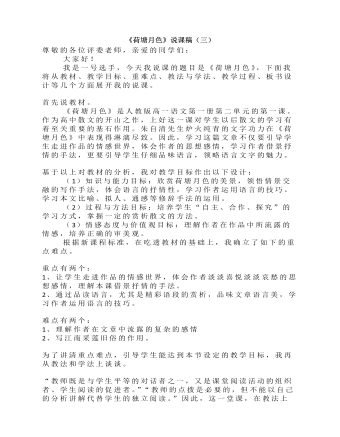
《荷塘月色》说课稿 (三)2022—2023学年统编版高中语文必修上册
环节二,在品读过程中把重点字词的读音和意义融入其中。这是新课程标准的体现环节三,提出问题:作者的思想情感在文中是怎样变化的?让学生带着这个问题再次自读课文。三、仔细品读,把握感情。引导学生去把握全文的感情基调,解决刚才提出的问题。 赏析语段,品味语言,在把握全文感情基调的基础上,启发学生联想,假设眼前有一片荷塘,设问学生会看到什么?很自然会看到:叶,花,闻到花香。在此基础上逐步引导学生赏析课文精彩语段四、五自然段,当然教师要作必要的启发指点,尤其是在那些容易被忽略之处,以下仅举一例: 荷香与歌声有什么可比的共同点?(领会通感手法的运用)在点拨通感这一修辞手法时,我举了诗人艾青描写日本著名指挥家小泽征尔的话:“你的眼睛在,你的耳朵在倾听。”这个例子能诗意的解释通感这一修辞手法。
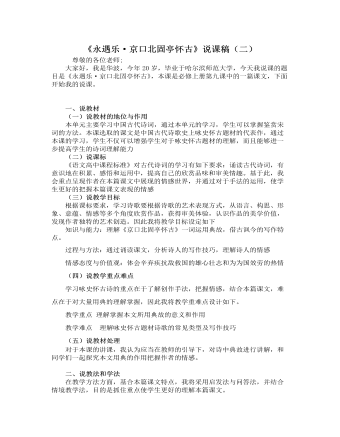
《永遇乐 · 京口北固亭怀古》说课稿(二) 2021-2022学年统编版高中语文必修上册
此环节运用的是合作探究法,采用小组讨论的形式开放回答即可。通过本课的学习,学生可以总结归纳出辛弃疾主张抗敌,收复失地的爱国热情对南宋政府苟且偏安的不满,吸取的历史教训,告诫当使用者不要草率用兵。对于决策者提出警告,抒发自己壮志难酬的感慨,教师总结归纳即可。本诗写出最大特点就是大量典故的运用。学生可以本诗对用点表达自己的看法,我将在在PPT展示诗歌用典的意义,意在帮助学生理解更好用典这种诗歌技巧。本篇是一首咏史怀古诗,本单元学习了两首同题材诗歌,有必要使学生掌握一类型的诗歌鉴赏方法。(五)比较阅读 品味历史这一环节PPT将展示上次课程学习的《念奴娇赤壁怀古》并从内容,形式等角度分析异同,采用提问的方法。此环节结束后简要归纳咏史怀古诗类型。目的是巩固加强对于咏史怀古题材诗歌理解,理解归纳咏史怀古诗题材类型。(六)布置作业 巩固感知鉴赏李白《越中览古》我将采用习题的形式,目的是使学生在实践中运用所学方法鉴赏咏史怀古诗。
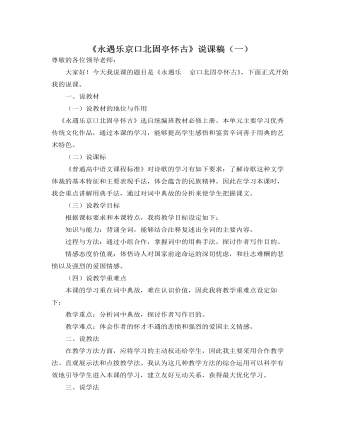
《永遇乐 · 京口北固亭怀古》说课稿(一) 2021-2022学年统编版高中语文必修上册
(三)以读带讲,感知文本1.学生朗读首先我会让学生结合书下的注释自由大声的朗读本篇课文,扫清文字障碍,感知词意。此环节可以让学生在诵读中解决词中的生字困难,疏通文意。2.教师范读我会声情并茂、感情充沛的进行配乐朗诵。此环节力求让学生感受到词的音乐美,懂得词的朗诵方法,为深入理解词的内容做准备。(四)精讲细读,深入文本此环节主要解决本课的重点,所以我会运用合作教学法和点拨教学法引导学生分析词中典故,探讨作者写作目的。首先我将学生分为孙权刘裕组、刘义隆组、拓跋焘组、廉颇组四个小组。然后对这四个小组分别提出思考问题,让学生以小组为单位解决我提出的问题。在学生讨论结束后分别找每个小组中的一位同学回答,并引导点拨学生答案。孙权刘裕组:

古诗词诵读《将进酒》说课稿2021-2022学年高中语文统编版选择性必修上册
一、说教材选修课是在必修课程基础上的拓展与提高,它力争促进学生各自特长和个性的形成。我们在必修部分已经学习了李白的一首古风《蜀道难》,学生对李白其人及其诗风已有了一定的了解。本单元的任务是“因声求气,吟咏诗韵”,它要求我们通过对古典诗歌声律特点的把握,学习有感情地吟咏,诵读作品,并深入地了解诗歌的感情。《将进酒》一诗时而奔放,时而深沉,感情大起大落变化明显,学生容易进入吟咏和体会情感的体验阅读中。二、说教法学法现代语文观念中提倡语文教学要多读,要培养学生的语感,特别是对一些优秀的古诗文。可见在学习古代诗文的过程中,诵读是非常重要的,有助于加深学生对课文思想内容的理解。可以在朗读中理解诗文的内容,所谓“读书百遍其义自见”,在反复的朗读中可以慢慢体会诗人所要表达的思想感情,因此本堂课我采取以诵读为线索,完成对诗歌思想内容的理性思考。
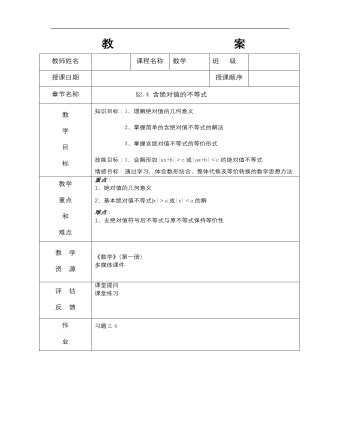
【高教版】中职数学基础模块上册:2.4《含绝对值的不等式》教案设计
教师姓名 课程名称数学班 级 授课日期 授课顺序 章节名称§2.4 含绝对值的不等式教 学 目 标知识目标:1、理解绝对值的几何意义 2、掌握简单的含绝对值不等式的解法 3、掌握含绝对值不等式的等价形式 技能目标:1、会解形如|ax+b|>c或|ax+b|<c的绝对值不等式 情感目标:通过学习,体会数形结合、整体代换及等价转换的数学思想方法教学 重点 和 难点重点: 1、绝对值的几何意义 2、基本绝对值不等式|x|>a或|x|<a的解 难点: 1、去绝对值符号后不等式与原不等式保持等价性教 学 资 源《数学》(第一册) 多媒体课件评 估 反 馈课堂提问 课堂练习作 业习题2.4课后记不等式的基本性质是初中就学习过的内容,分式不等式的解法是哦本节课的一个重点和难点,尤其是不等号另一边不为0的情况,需要移项,这一点在强调前学生考虑不到,因此解题错误多。区间是个新内容,学生往往将连续的正数写作一个区间,这是常见的错误,要进行提醒。另外,在均值不等式这里稍微补充了一些内容,引起学生的兴趣。
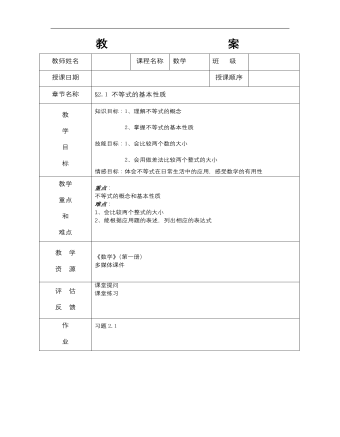
【高教版】中职数学基础模块上册:2.1《不等式的基本性质》教案设计
教师姓名 课程名称数学班 级 授课日期 授课顺序 章节名称§2.1 不等式的基本性质教 学 目 标知识目标:1、理解不等式的概念 2、掌握不等式的基本性质 技能目标:1、会比较两个数的大小 2、会用做差法比较两个整式的大小 情感目标:体会不等式在日常生活中的应用,感受数学的有用性教学 重点 和 难点 重点: 不等式的概念和基本性质 难点: 1、会比较两个整式的大小 2、能根据应用题的表述,列出相应的表达式教 学 资 源《数学》(第一册) 多媒体课件评 估 反 馈课堂提问 课堂练习作 业习题2.1课后记
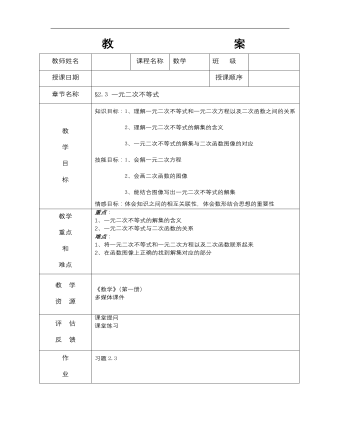
【高教版】中职数学基础模块上册:2.3《一元二次不等式》教案设计
教师姓名 课程名称数学班 级 授课日期 授课顺序 章节名称§2.3 一元二次不等式教 学 目 标知识目标:1、理解一元二次不等式和一元二次方程以及二次函数之间的关系 2、理解一元二次不等式的解集的含义 3、一元二次不等式的解集与二次函数图像的对应 技能目标:1、会解一元二次方程 2、会画二次函数的图像 3、能结合图像写出一元二次不等式的解集 情感目标:体会知识之间的相互关联性,体会数形结合思想的重要性教学 重点 和 难点重点: 1、一元二次不等式的解集的含义 2、一元二次不等式与二次函数的关系 难点: 1、将一元二次不等式和一元二次方程以及二次函数联系起来 2、在函数图像上正确的找到解集对应的部分教 学 资 源《数学》(第一册) 多媒体课件评 估 反 馈课堂提问 课堂练习作 业习题2.3课后记本节课内容是比较重要的,是一元二次方程、一元二次函数、一元二次不等式的结合,相关知识点融会贯通,数形结合的思想方法在这有很好的运用。三种情况只要讲清楚一种,另外两种可由学生自行推出结论。
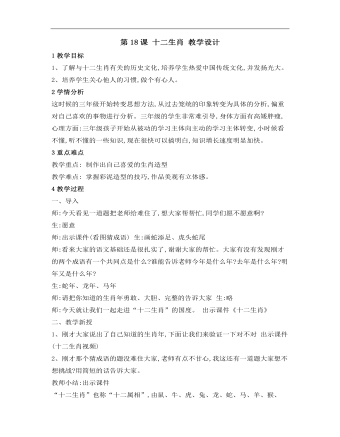
小学美术桂美版三年级上册《第18课十二生肖1》教学设计说课稿
一、导入师:今天看见一道题把老师给难住了,想大家帮帮忙,同学们愿不愿意啊?生:愿意师:出示课件(看图猜成语) 生:画蛇添足、虎头蛇尾师:看来大家的语文基础还是很扎实了,谢谢大家的帮忙。大家有没有发现刚才的两个成语有一个共同点是什么?谁能告诉老师今年是什么年?去年是什么年?明年又是什么年?生:蛇年、龙年、马年师:请把你知道的生肖年勇敢、大胆、完整的告诉大家 生:略师:今天就让我们一起走进“十二生肖”的国度。 出示课件《十二生肖》
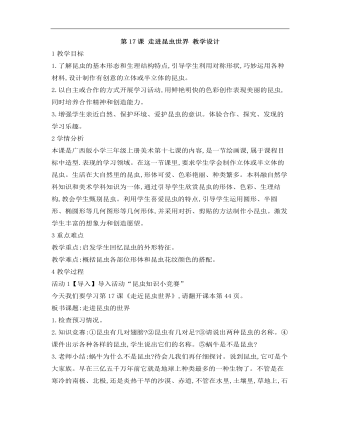
小学美术桂美版三年级上册《第17课走进昆虫世界》教学设计说课稿
2学情分析 本课是广西版小学三年级上册美术第十七课的内容,是一节绘画课,属于课程目标中造型.表现的学习领域。在这一节课里,要求学生学会制作立体或半立体的昆虫。生活在大自然里的昆虫,形体可爱、色彩艳丽、种类繁多。本科融自然学科知识和美术学科知识为一体,通过引导学生欣赏昆虫的形体、色彩、生理结构,教会学生甄别昆虫。利用学生喜爱昆虫的特点,引导学生运用圆形、半圆形、椭圆形等几何图形等几何形体,并采用对折、剪贴的方法制作小昆虫。激发学生丰富的想象力和创造愿望。
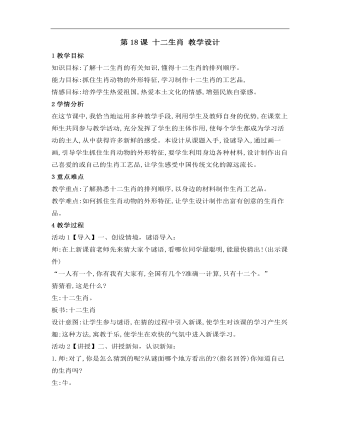
小学美术桂美版三年级上册《第18课十二生肖2》教学设计说课稿
2学情分析在这节课中,我恰当地运用多种教学手段,利用学生及教师自身的优势,在课堂上师生共同参与教学活动,充分发挥了学生的主体作用,使每个学生都成为学习活动的主人,从中获得许多新鲜的感受。本设计从课题入手,设谜导入,通过画一画,引导学生抓住生肖动物的外形特征,要学生利用身边各种材料,设计制作出自己喜爱的或自己的生肖工艺品,让学生感受中国传统文化的源远流长。
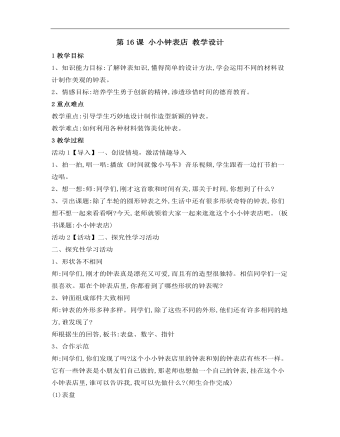
小学美术桂美版三年级上册《第16课小小钟表店1》教学设计说课稿
3教学过程活动1【导入】一、创设情境,激活情趣导入 1、拍一拍,唱一唱:播放《时间就像小马车》音乐视频,学生跟着一边打节拍一边唱。2、想一想:师:同学们,刚才这首歌和时间有关,那关于时间,你想到了什么?3、引出课题:除了车轮的圆形钟表之外,生活中还有很多形状奇特的钟表,你们想不想一起来看看啊?今天,老师就领着大家一起来逛逛这个小小钟表店吧。(板书课题:小小钟表店)
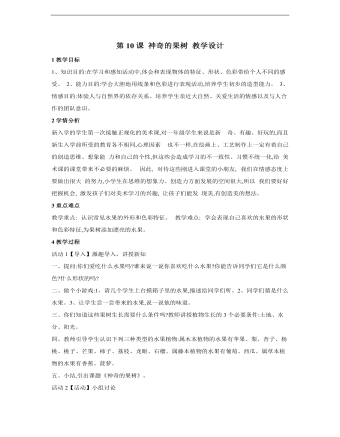
小学美术桂美版一年级上册《第10课神奇的果树》教学设计说课稿
2学情分析 新入学的学生第一次接触正规化的美术课,对一年级学生来说是新 奇、有趣、好玩的,而且新生入学前所受的教育各不相同,心理因素 也不一样,在绘画上、工艺制作上一定有着自己的创造思维、想象能 力和自己的个性,但这些会造成学习的不一致性、习惯不统一化,给 美术课的课堂带来不必要的麻烦。因此, 对待这些刚进入课堂的小朋友, 我们在情感态度上要做出很大 的努力,小学生在思维的想象力、创造力方面发展的空间很大,所以 我们要好好把握机会, 激发孩子们对美术学习的兴趣,让孩子们能发 现美,有创造美的想法。
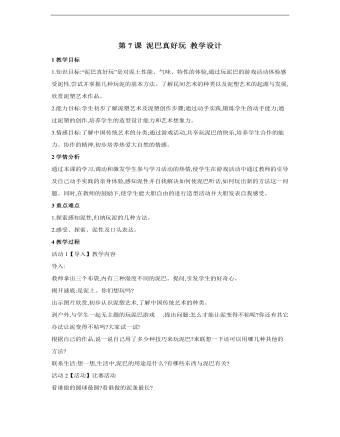
小学美术桂美版一年级上册《第7课泥巴真好玩》教学设计说课稿
2学情分析 通过本课的学习,调动和激发学生参与学习活动的热情,使学生在游戏活动中通过教师的引导及自己动手实践的亲身体验,感知泥性并自我解决如何使泥巴听话,如何玩出新的方法这一问题。同时,在教师的鼓励下,使学生能大胆自由的进行造型活动并大胆发表自我感受。3重点难点 1.探索感知泥性,归纳玩泥的几种方法。2.感受、探索、泥性及口头表达。
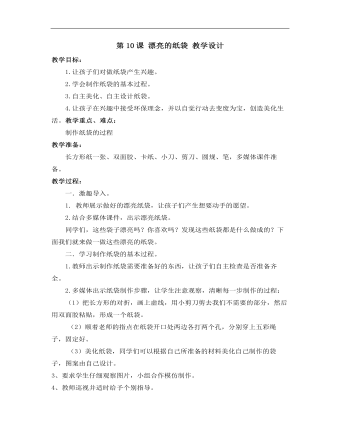
小学美术桂美版三年级上册《第10课漂亮的纸袋》教学设计说课稿
一.激趣导入。 1. 教师展示做好的漂亮纸袋,让孩子们产生想要动手的愿望。 2.结合多媒体课件,出示漂亮纸袋。 同学们,这些袋子漂亮吗?你喜欢吗?发现这些纸袋都是什么做成的?下面我们就来做一做这些漂亮的纸袋。 二.学习制作纸袋的基本过程。 1.教师出示制作纸袋需要准备好的东西,让孩子们自主检查是否准备齐全。 2.多媒体出示纸袋制作步骤,让学生注意观察,清晰每一步制作的过程: (1)把长方形的对折,画上虚线,用小剪刀剪去我们不需要的部分,然后用双面胶粘贴,形成一个纸袋。

